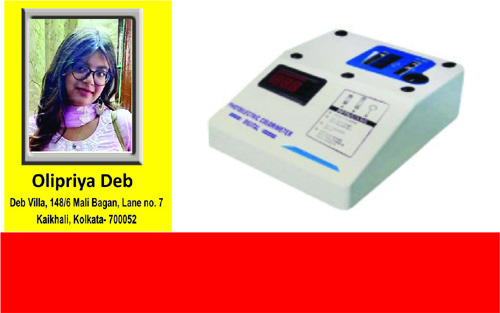HUMAN PHYSIOLOGY
PRINCIPLE OF SPECTROPHOTOMETER AND COLORIMETER

✍️ – Written By Olipriya Deb
Deb Villa, 148/6 Mali Bagan, Lane no. 7, Kaikhali, Kolkata- 700052
A spectrophotometer is an instrument that measures either the amount of light reflected
from a sample object or the amount of light that is absorbed by the sample object. It is
important to know the design of the device.
The sequence of events in a modern spectrophotometer is as follows:
-
The light source shines on the sample.
-
A fraction of the light is transmitted or reflected from the sample
-
The light from the sample is directed to the entrance slit of the monochromator
-
The monochromator separates the wavelengths of light and focuses each of them onto the photodetector sequentially.
There are two kinds of spectrophotometers: single beam and double beam. A double beam spectrophotometer compares the light intensity between two light paths. One path containing a reference sample, the other holding the test sample. A single beam spectrophotometer measures the relative light intensity of the beam before and after a test sample is inserted. A double beam machine makes comparison readings easier and more stable. But a single beam machine can have measure a wider range of light frequencies. Single beam machines have simple optical systems and are more compact. When the spectrophotometer is built into another device (like microscopes or telescopes) only single beam machines will work.
PRINCIPLE:- Spectrophotometry is a method to measure how much a chemical substance absorbs light by measuring the intensity of light as a beam of light passes through sample solution. The basic principle is that e ach compound absorbs or transmits light over a certain range of wavelength.
In this device, we can see the major application of Beer Lambert’s Law.
The spectrophotometer can be operated in the UV region, Visible spectrum and IR spectrum as well. This instrument is based on photometric techniques. According to photometric technique, when a beam of incident light of intensity I0 , passes through a solution, a part of the incident light is reflected, a part is absorbed and the rest of the light is transmitted. If the part of incident light which got reflected is Ir , the part which got absorbed is Ia and the part which got transmitted is It . Then we can write – I0 = Ir + Ia + It.

A colorimeter is a device used in colorimetry that measures the absorbance of particular
wavelengths of light by a specific solution. It is commonly used to determine the
concentration of a known solute in a given solution by the application of the Beer–Lambert
law, which states that the concentration of a solute is proportional to the absorbance.
The essential parts of a colorimeter are:-
-
a light source (low-voltage filament lamp);an adjustable aperture;
-
a set of colored filters;
-
a cuvette to hold the working solution;
-
a detector (usually a photoresistor) to measure the transmitted light;
-
a meter to display the output from the detector.
PRINCIPLE:- It is a photometric technique which states that when a beam of incident light of intensity Io passes through a solution, the following occur:
A part of it is reflected which is denoted as Ir
A part of it is absorbed which is denoted as Ia
Rest of the light is transmitted and is denoted as It
Therefore, Io = Ir + Ia + It
To determine Ia the measurement of Io and It is sufficient therefore, Ir is eliminated. The
amount of light reflected is kept constant to measure Io and It.
Colorimeter is based on two fundamental laws of photometry i.e. Beer Lambert’s Law.

References-
-
Medical Physiology by Mahapatra
-
Human Physiology by AK Jain
-
Laboratory Manual by David Mill
-
Website- www.wikipedia.com
____________________________________
![]()













